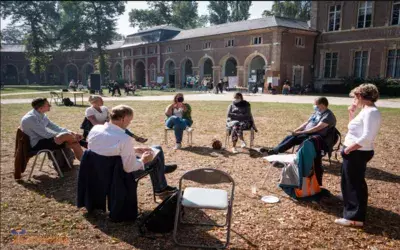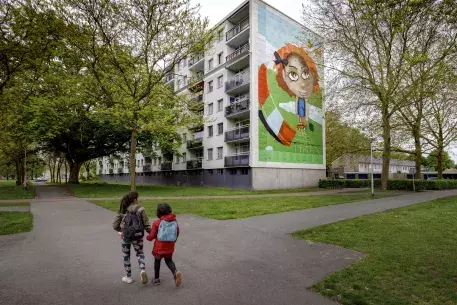Introduction

Collaborative, non-market oriented housing is considered a valuable response to the chronic housing crisis (Tummers 2016). It provides new solutions for improving access to adequate, sustainable homes, alongside public social housing schemes. With appropriate land policies, community-oriented housing can enable residents to put their own housing needs before private profits.

Approaches to collaborative housing and degrees of municipality involvement vary enormously between cities. Examples include community-led, participative co-housing, self-build, cooperatives, Community Land Trusts, ecological housing initiatives and social production of housing. Models vary according to factors such as the philosophy of the people engaged in their common project, and the socio-economic and legal context – and national legacies of past collaborative housing movements (Matthew Thompson, 2020)
Setting the scene : Shared values, self-reliance, economic viability.
“(Collaborative) housing is defined by high degrees of user participation, the establishment of reciprocal relationships, mutual help and solidarity, and different forms of crowd finances and management […],” (Cziscke 2018). These solutions can take the form of so-called ‘intentional communities’, whose members share common values, mutual self-reliance and an ethos of solidarity, care and wellbeing. These communities often target a specific group, such as seniors, couples, or singles, and can also be gender oriented. If well managed, by sharing facilities and resources they can lower costs and improve economic performance.
Sometime misleadingly called community-led housing, co-living spaces, also dubbed ‘co-housing projects’, can be elite, middle-class, race enclosures of ecological, expensive living. In these cases, the sense of community ‘ togetherness ’ has been coopted by the market and exploited by profiled designers, professionals, or investors for a wealthy clientele, thus creating new venues for financial speculation in the housing sector. On the other hand, progressive collaborative projects reject the commodification of housing, by engaging future residents as agents of individual and collective autonomy, social inclusion, solidarity economy, ethical financial solutions and participatory design.
Maximising the benefits of collaboration housing
The concept of collaborative housing is growing widely in policy discourses, research and city administrations around the world. The UN’s New Urban Agenda encourages “cooperative solutions such as co-housing, community land trust, and other forms of collective tenure” to improve housing supply. And the EU Urban Agenda Housing Partnership believes that, “empowering consumers and communities”, can bring financial, social and community benefits.
Collaborative housing schemes have flourished in places with legal systems that accommodate them (one example is France’s 2014 ALUR law organismes de foncier solidaire’ OFS). Although there had not been a strong European movement on CLT, the Sustainable Housing for Inclusive and Cohesive Cities (SCHICC) Interreg project is now changing the status quo, promoting further establishment and dissemination of the CLT model at EU level. Nevertheless, the diversity of European countries’ planning and conservation legislation still hampers access to certain funding and provision of housing through citizen-organised initiatives.
Cities in action
These examples of innovative city strategies to support collaborative housing are selected from UIA projects and URBACT networks, and from other experiences shared during the ‘Cities engaging in the right to housing’ initiative.
Brussels
Community Land Trust as an alternative to real estate speculation
CALICO is an intergenerational, collaborative, care housing project co-managed by Brussels Logement regional authority and Community Land Trust Brussels (CLTB).
Launched in 2018, CALICO secures the affordability of a multi-storey building, with apartments shared among three partners: CLTB; a feminist association; and an NGO accompanying individuals and families in crucial moments of life and death.
Additional apartments are available for people experiencing homelessness, and common spaces are open to CALICO residents and neighbours. Decision-making is based on sociocracy – a democratic governance system that includes not only public authorities and residents, but also neighbours and civil society representatives.
The land is secured through a trust managed by the CLTB. While CLTs are usually based on homeownership, the experiment here is to include affordable housing units for rent.
This innovation – made possible in part by UIA funding – is unique, and a promising step towards scaling up the project to city and national level.
Budapest
Municipality and residents co-creating regenerative housing
In a city whose public housing sector is rapidly shrinking, the E-CO-HOUSING project, located in the district of Zugló, is designed to create an environmentally sustainable living community.
The aim is to create a prototype for an economically feasible, environmentally sustainable, social housing scheme that can be replicated in other parts of Budapest and in other cities.
In cooperation with green technology companies, environmental and social NGOs, and a university, the district municipality has engaged a focus group to co-design a housing block with community spaces, shared facilities and smart technology solutions, allowing future residents to monitor their energy consumption.
Zurich
A long tradition of cooperative housing
While not the most affordable way to live in Switzerland, the most traditional form of collaborative housing – housing cooperatives – has existed here since the early 1900s, in a great diversity of forms.
In the 1980s, new ideas about living together (known as the Wohngemeinschaft concept) inspired a new generation of cooperatives. Today, cooperative housing in the cantons of Zurich and Biel makes up nearly 20% of the market.
In Zurich, 25% of all rented flats are not-for-profit, and there are about 35 000 cooperative housing units. Local and regional housing subsidies are complemented by federal mortgage guarantees and a central issue office for non-profit housing construction.
In addition, the Swiss Housing Cooperatives Association helps new housing projects with revolving funds, solidarity funds and equity participation.
Berlin
Berlin, a new Community Land Trust in a dynamic housing scene
Berlin’s complex housing collaborations range from squatter movement collectives to intentional co-living communities of specific groups such as LGBT or the elderly.
Examples are the so-called Baugruppes, groups of future residents who commission or build their own housing development, and the Genossenschaften building cooperatives that ensure affordable rents for all members.
Meanwhile, Berlin is experimenting the first CLT in Germany – called Stadtbodenstiftung – a democratically controlled local organisation run as a foundation, with direct participation of residents, neighbours, donors, public bodies and experts.
More than single housing projects, the Berlin CLT allows housing activists to build a more coherent policy framework across the city, closer cooperation with local government, broader democratic decision-making structures and a more solid, long-term perspective for collaborative housing.
Podcast : https://open.spotify.com/episode/2Sf2fjkeXTajvq4FSPnwqh
Key takeaways
Reflexions shared over the course of the UIA-URBACT ‘Cities engaging in the right to housing’ initiative in 2020 revealed key actions governments can take to support collaborative housing.
- City administrations should ensure a mix of housing development and ownership, including community-led housing, and further strengthen the social mix within neighbourhoods.
- City administrations are valuable partners in collaborative housing projects promoting alliances among a broad range of stakeholders, and supporting the creation of cooperatives, CLT, and other forms of collective management of goods.
- City administrations can create in-house agencies to support and encourage the realisation of collaborative experimental projects. Expertise should be available to help citizens’ initiatives, improving access to information, for example on existing legislation, land management, VAT, insurance costs, or competences – and to training, for example on how to launch and manage a cooperative, or technical training for self-built constructions.
- Collaborative housing is not a single solution but can be a valuable complement to state- or municipality-led public housing schemes
- More non-market oriented housing solutions should be encouraged to flourish and governments at all levels should support them.
About this resource
The Urban Innovative Actions (UIA) is a European Union initiative that provided funding to urban areas across Europe to test new and unproven solutions to urban challenges. The initiative had a total ERDF budget of €372 million for 2014-2020.
Similar content




